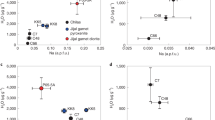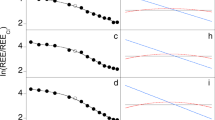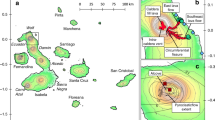Abstract
Volcanic glasses observed on the lunar surface have been interpreted as the products of volatile-rich, fire-fountain eruptions. Revised estimates of the water content of primitive lunar magmas have overturned the notion of a volatile-poor Moon1,2,3,4, but degassing of water-rich vapour during volcanic eruptions is inconsistent with geochemical and petrological observations5,6. Although degassing of carbon is compatible with observations, the amount of indigenous carbon in lunar volcanic materials is not well constrained. Here we present high-precision measurements of indigenous carbon contents in primitive lunar volcanic glasses and melt inclusions. From our measurements, in combination with solubility and degassing model calculations, we suggest that carbon degassed before water in lunar magmas, and that the amount of carbon in the lunar lavas was sufficient to trigger fire-fountain eruptions at the lunar surface. We estimate—after correcting for bubble formation in the melt inclusions—that the primitive carbon contents and hydrogen/carbon ratios of lunar magmas fall within the range found in melts from Earth’s depleted upper mantle7. Our findings are also consistent with measurements of hydrogen, fluorine, sulphur and chlorine contents, as well as carbon and hydrogen isotopes, in primitive lunar magmas2,3,4,8,9, suggesting a common origin for the volatile elements in the interiors of the Earth and Moon.
This is a preview of subscription content, access via your institution
Access options
Subscribe to this journal
Receive 12 print issues and online access
$259.00 per year
only $21.58 per issue
Buy this article
- Purchase on Springer Link
- Instant access to full article PDF
Prices may be subject to local taxes which are calculated during checkout



Similar content being viewed by others
References
Saal, A. E. et al. Volatile content of lunar volcanic glasses and the presence of water in the Moon’s interior. Nature 454, 192–195 (2008).
Hauri, E. H., Weinreich, T., Saal, A. E., Rutherford, M. C. & Van Orman, J. A. High pre-eruptive water contents preserved in lunar melt inclusions. Science 333, 213–215 (2011).
Saal, A. E., Hauri, E. H., Van Orman, J. A. & Rutherford, M. J. Hydrogen isotopes in lunar volcanic glasses and melt inclusions reveal a carbonaceous chondrite heritage. Science 340, 1317–1320 (2013).
Füri, E., Deloule, E., Gurenko, A. & Marty, B. New evidence for chondritic lunar water from combined D/H and noble gas analyses of single Apollo 17 volcanic glasses. Icarus 229, 109–120 (2014).
Sharp, Z. D., Shearer, C. K., McKeegan, K. D., Barnes, J. D. & Wang, Y. Q. The chlorine isotope composition of the Moon and implications for an anhydrous mantle. Science 329, 1050–1053 (2010).
Shearer, C. K. et al. Origin of sulfide replacement textures in lunar breccias. Implications for vapor element transport in the lunar crust. Geochim. Cosmochim. Acta 83, 138–158 (2012).
Saal, A. E., Hauri, E. H., Langmuir, C. H. & Perfit, M. R. Vapour undersaturation in primitive mid-ocean-ridge basalt and the volatile content of Earth’s upper mantle. Nature 419, 451–455 (2002).
Epstein, S. & Taylor, H. P. Jr The isotopic composition and concentration of water, hydrogen, and carbon in some Apollo 15 and 16 soils and in the Apollo 17 orange soil. Geochim. Cosmochim. Acta 2, 1559–1575 (1973).
Hauri, E. H., Saal, A. E., Rutherford, M. C. & Van Orman, J. A. Water in the Moon’s interior: Truth and consequences. Earth Planet. Sci. Lett. 409, 252–264 (2015).
Marty, B. The origins and concentrations of water, carbon, nitrogen and noble gases on Earth. Earth Planet. Sci. Lett. 313–314, 56–66 (2012).
Halliday, A. N. The origins of volatiles in the terrestrial planets. Geochim. Cosmochim. Acta 105, 146–171 (2013).
Elkins-Tanton, L. T., Chatterjee, N. & Grove, T. L. Magmatic processes that produced lunar fire fountains. Geophys. Res. Lett. 30, 1513 (2003).
Sato, M. The driving mechanism of lunar pyroclastic eruptions inferred from the oxygen fugacity behavior of Apollo 17 orange glass. Proc. Lunar Planet. Sci. Conf. 10, 311–325 (1979).
Rutherford, M. J. & Papale, P. Origin of basalt fire-fountain eruptions on Earth versus the Moon. Geology 37, 219–222 (2009).
Fogel, R. A. & Rutherford, M. J. Magmatic volatiles in primitive lunar glasses: I. FTIR and EPMA analyses of Apollo 15 green and yellow glasses and revision of the volatile-assisted fire-fountain theory. Geochim. Cosmochim. Acta 59, 201–215 (1995).
Nicholis, M. G. & Rutherford, M. J. Graphite oxidation in the Apollo 17 orange glass magma: Implications for the generation of a lunar volcanic gas phase. Geochim. Cosmochim. Acta 73, 5905–5917 (2009).
Delano, J. W. Apollo 15 green glass—Chemistry and possible origin. Proc. Lunar Planet. Sci. Conf. 10, 275–300 (1979).
Dixon, J. E., Stolper, E. M. & Holloway, J. R. An experimental study of water and carbon dioxide solubilities in mid-ocean ridge basaltic liquids. Part I: Calibration and solubility models. J. Petrol. 36, 1607–1631 (1995).
Dixon, J. E. & Stolper, E. M. An experimental study of water and carbon dioxide solubilities in mid-ocean ridge basaltic liquids. Part II: Applications to degassing. J. Petrol. 36, 1633–1646 (1995).
Wetzel, D. T., Rutherford, M. J., Jacobsen, S. D., Hauri, E. H. & Saal, A. E. Degassing of reduced carbon from planetary basalts. Proc. Natl Acad. Sci. USA 110, 8010–8013 (2013).
Newcombe, M. et al. Solubility and diffusivity of H-bearing species in lunar basaltic melts. Lunar Planet. Sci. Conf. 43, 2777 (2012).
Ardia, P., Hirschmann, M. M., Withers, A. C. & Stanley, B. D. Solubility of CH4 in a synthetic basaltic melt, with applications to atmosphere–magma ocean–core partitioning of volatiles and to the evolution of the Martian atmosphere. Geochim. Cosmochim. Acta 114, 52–71 (2013).
Hirschmann, M. M., Withers, A. C., Ardia, P. & Foley, N. T. Solubility of molecular hydrogen in silicate melts and consequences for volatile evolution of terrestrial planets. Earth Planet. Sci. Lett. 345–348, 38–48 (2012).
Zhang, C. & Duan, Z. A model for C–O–H fluid in the Earth’s mantle. Geochim. Cosmochim. Acta 73, 2089–2102 (2009).
Wieczorek, M. A. et al. The crust of the Moon as seen by GRAIL. Science 339, 671–675 (2013).
Wilson, L. & Head, J. W. Deep generation of magmatic gas on the Moon and implications for pyroclastic eruptions. Geophys. Res. Lett. 30, 1605 (2003).
Hess, P. C. & Parmentier, E. M. Thermal evolution of a thicker KREEP liquid layer. J. Geophys. Res. 106, 28023–28032 (2001).
Longhi, J., Walker, D. & Hays, J. F. The distribution of Fe and Mg between olivine and lunar basaltic liquids. Geochim. Cosmochim. Acta 42, 1545–1558 (1978).
Exley, R. A., Mattey, D. P., Clague, D. A. & Pillinger, C. T. Carbon isotope systematics of a mantle “hotspot”: A comparison of Loihi Seamount and MORB glasses. Earth Planet. Sci. Lett. 78, 189–199 (1986).
Koga, K., Hauri, E. H., Hirschmann, M. M. & Bell, D. Hydrogen concentration analyses using SIMS and FTIR: Comparison and calibration for nominally anhydrous minerals. Geochem. Geophys. Geosyst. 4, 1019 (2003).
Hauri, E. H. et al. SIMS analysis of volatiles in silicate glasses: 1. Calibration, matrix effects and comparisons with FTIR. Chem. Geol. 183, 99–114 (2002).
Silver, L. & Stolper, E. Water in albitic glasses. J. Petrol. 30, 667–709 (1989).
Gaillard, F. & Scaillet, B. A theoretical framework for volcanic degassing chemistry in a comparative planetology perspective and implications for planetary atmospheres. Earth Planet. Sci. Lett. 403, 307–316 (2014).
Vander Kaaden, K. E., Agee, C. B. & McCubbin, F. M. A comparison of melt density and compressibility of the green, yellow, and orange Apollo glasses as a function of TiO2 content. Lunar Planet. Sci. Conf. 43, 1584 (2012).
van Kan Parker, M. et al. Neutral buoyancy of titanium-rich melts in the deep lunar interior. Nature Geosci. 5, 186–189 (2012).
Delano, J. W. Buoyancy-driven melt segregation in the Earth’s moon. I- Numerical results. Proc. Lunar Planet. Sci. Conf. 20, 3–12 (1990).
Uhlmann, D. R., Cukierman, M., Scherera, G. & Hopper, R. W. Viscous flow, crystallization behavior and thermal history of orange soil material. Eos Trans. Am. Geophys. Union 54, 617–618 (1973).
Chaussidon, M. & Robert, F. Lithium nucleosynthesis in the Sun inferred from the solar-wind 7Li/6Li ratio. Nature 402, 270–273 (1999).
Hashizume, K., Chaussidon, M., Marty, B. & Terada, K. Protosolar carbon isotopic composition: Implications for the origin of meteoritic organics. Astrophys. J. 600, 480–484 (2004).
Hashizume, K., Chaussidon, M., Marty, B. & Robert, F. Solar wind record on the Moon: Deciphering presolar from planetary nitrogen. Science 290, 1142–1145 (2000).
Ozima, M. et al. Terrestrial nitrogen and noble gases in lunar soils. Nature 436, 655–659 (2005).
Eugster, O., Terribilini, D., Polnau, E. & Kramers, J. The antiquity indicator argon-40/argon-36 for lunar surface samples calibrated by uranium-235-xenon-136 dating. Meteorit. Planet. Sci. 36, 1097–1115 (2001).
Eugster, O. et al. The cosmic-ray exposure history of Shorty Crater samples—The age of Shorty Crater. Proc. Lunar Planet. Sci. Conf. 8, 3059–3082 (1977).
Podosek, F. A. & Huneke, J. C. Argon in Apollo 15 green glass spherules (15426): 40Ar–39Ar age and trapped argon. Earth Planet. Sci. Lett. 19, 413–421 (1973).
Eugster, O., Groegler, N., Eberhardt, P., Geiss, J. & Kiesl, W. Double drive tube 74001/2—A two-stage exposure model based on noble gases, chemical abundances and predicted production rates. Proc. Lunar Planet. Sci. Conf. 12, 541–558 (1982).
Lakatos, S., Heymann, D. & Yaniv, A. Green spherules from Apollo 15: Inferences about their origin from inert gas measurements. The Moon 7, 132–148 (1973).
Fleischer, R. L. & Hart, H. R. Jr Particle track record of Apollo 15 green soil and rock. Earth Planet. Sci. Lett. 18, 357–364 (1973).
Spangler, R. R., Warasila, R. & Delano, J. W. 39Ar–40Ar ages for the Apollo 15 green and yellow volcanic glasses. J. Geophys. Res. 89, B487–B497 (1984).
Spangler, R. R. & Delano, J. W. History of the Apollo 15 yellow impact glass and sample 15426 and 15427. J. Geophys. Res. 89, B478–B486 (1984).
Kirsten, T., Horn, P., Heymann, D., Hubner, W. & Storzer, D. Apollo 17 crystalline rocks and soils: Rare gasses, ion track and ages. Eos Trans. Am. Geophys. Union 54, 595–597 (1973).
Schaeffer, O. A. & Husain, L. Isotopic ages of Apollo 17 lunar material. Eos Trans. Am. Geophys. Union 54, 614 (1973).
Hintenberger, H., Weber, H. W. & Schultz, L. Solar, spallogenic, and radiogenic rare gases in Apollo 17 soils and breccias. Proc. Lunar Planet. Sci. Conf. 5, 2005–2022 (1974).
Merlivat, L., Lelu, M., Nief, G. & Roth, E. Spallation deuterium in rock 70215. Proc. Lunar Planet. Sci. Conf. 7, 649–658 (1976).
Reedy, R. C. Cosmic-ray-produced stable nuclides: Various production rates and their implications. Proc. Lunar Planet. Sci. Conf. 12, 871–873 (1981).
Acknowledgements
We thank J. Wang for careful attention to the health of the Carnegie NanoSIMS. This study was supported by NASA LASER to A.E.S. (NNX08AY97G) and to M.J.R. (NNX11AB27G), by NASA Cosmochemistry to A.E.S. (NNX12AH62G), by the NASA Solar System Exploration Research Virtual Institute (SSERVI) to Brown University (NNA14AB01A) Deep Carbon Observatory and by the Carnegie Institution of Washington.
Author information
Authors and Affiliations
Contributions
All authors devised the project and interpreted the data. D.T.W. and M.J.R. carried out the experiments. E.H.H. was responsible for data acquisition. D.T.W. performed the computer simulations. D.T.W. and A.E.S. wrote the paper with input from all co-authors.
Corresponding author
Ethics declarations
Competing interests
The authors declare no competing financial interests.
Supplementary information
Supplementary Information
Supplementary Information (PDF 891 kb)
Rights and permissions
About this article
Cite this article
Wetzel, D., Hauri, E., Saal, A. et al. Carbon content and degassing history of the lunar volcanic glasses. Nature Geosci 8, 755–758 (2015). https://doi.org/10.1038/ngeo2511
Received:
Accepted:
Published:
Issue Date:
DOI: https://doi.org/10.1038/ngeo2511
This article is cited by
-
Compositional Mapping and Spectral Analysis of Sulpicius Gallus Dark Mantling Deposits Using Lunar Orbital Data Sets Including Chandrayaan-1 Moon Mineralogy Mapper
Journal of the Indian Society of Remote Sensing (2022)
-
The Diverse Planetary Ingassing/Outgassing Paths Produced over Billions of Years of Magmatic Activity
Space Science Reviews (2021)
-
Deep hydrous mantle reservoir provides evidence for crustal recycling before 3.3 billion years ago
Nature (2019)
-
The lunar core can be a major reservoir for volatile elements S, Se, Te and Sb
Scientific Reports (2017)
-
Carbon in the Moon
Nature Geoscience (2015)



